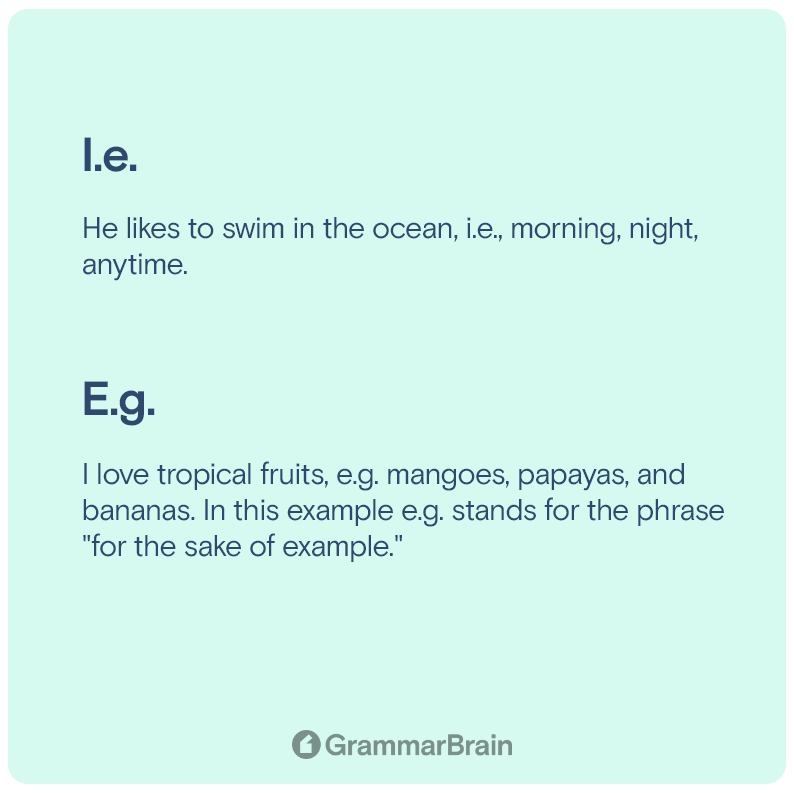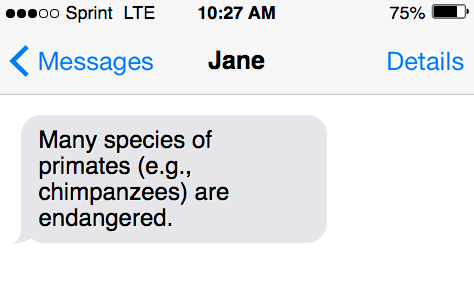Latin abbreviations i.e. and e.g. are small forms that can get awfully confusing. When used incorrectly, they can give the exact opposite meaning to the writer’s intention. When used correctly, it can assist in the flow of thought.
In the article below, we’re going to help you understand the difference between the two Latin abbreviations. Their general use in the English language. And help save you time and frustration when writing.
Learn the difference between “i.e.,” and “e.g.” in this short grammar guide…

What does “i.e.” mean?
I.e. is a short form of the Latin expression id est which means “that is”.
The term is commonly used for introducing an elaboration. Or rephrasing something that has already been stated.
To gain a more superficial understanding, it is recommended to associate the “i” with “in other words.” Similarly, the “e” can stand for “in essence.”
| Latin abbreviation | Definition |
| i.e. | I.e. stands for the Latin id est, or ‘that is,’ and is used to introduce a word or phrase that restates what has been said previously. |
Here are some examples that show i.e., in use:
- I prefer to eat sweet fruits i.e., juicy edible fruits with sweet pulp inside. In this example i.e. helps introduce a description of sweet fruit.
- Besides traveling I am passionate about solo motorcycle tours i.e., traveling hundreds of kilometers on a bike with all the gear and supplies.
I.e. is very helpful when used to help explain or define a term or concept that is unknown to the reader. Sometimes, i.e. is written within parentheses or brackets. An em dash or comma can also follow it. In most cases, i.e. is followed by a comma.
The use of these Latin abbreviations, along with the correct punctuation, makes writing clearer.
Many writers get confused about which abbreviation to use. And do not correctly recognize the meaning that represents them.
As a rule of thumb, i.e. should never begin sentences. Sentences should always begin with “therefore” or “for example.” These transition sentences and words help to bridge the gap between the topic, subject, and conclusion of the paragraph.
I.e. can get used within a sentence to further clarify any idea using a substitute.

Here are examples:
- Today audience enjoys realism-i.e. less stylized movies with settings, characters, and other aspects relating to everyday life. Here i.e. can be substituted using phrases like “in essence.”
- The employees will receive an additional bonus, i.e., 15 percent. In this example i.e. can be easily replaced with “that is.”
- The restaurant has no place to sit (i.e. there are over 100 occupants inside). Here i.e. helps qualify what describes an overcrowded restaurant.
What does “e.g.” mean?
E.g. is the short term for “exempli gratia.” It is a Latin phrase that translates as “for the sake of example.” e.g. is helpful to use when writing English to present one or more examples.
The primary purpose of e.g. is to introduce more than one example and not a complete list.
E.g. is mainly followed by a comma or an em dash. Or is found between parentheses.
| Latin Abbreviation | Definition |
| E.g. | E.g. means “for example.” (It stands for exempli gratia in Latin.) It is used in much the same ways as ‘for example,’ coming before an item or list of items. |
Here are examples:
- I love tropical fruits, e.g. mangoes, papayas, and bananas. In this example e.g. stands for the phrase “for the sake of example.”
- Some of my favorite books are short stories (e.g.) here e.g. is used inside parentheses to introduce examples of short stories the speaker likes.
- My father has traveled to various European countries-e.g., France, Austria, Hungary, and Belgium. This example shows, e.g., highlighting a small list of countries the subject in the sentence has visited.

How to use “e.g.” properly
Most commonly, it’s best to use “e.g.” inside of parenthesis. Here are examples:
- Incorrect: Many species of primates, e.g. chimpanzees, are endangered.
- Correct: Many species of primates (e.g., chimpanzees) are endangered.
- Correct: Many species of primates, such as chimpanzees, are endangered.
How to use “i.e.” properly
The Latin abbreviation “i.e.” should always appear after the first section of the sentence, in the middle of it (the transition or topic), making it grammatically correct. Here are examples:
- Incorrect: He likes the ocean. I.e., swimming in it.
- Correct: He likes to swim in the ocean, i.e., morning, night, anytime.
When to use “i.e.” vs. “e.g.”
“I.e.” and “e.g.” might appear similar, but the applications for these Latin abbreviations are entirely different.
The use of a mnemonic device helps people remember when to use “i.e.” or “e.g.” Some say that remembering that “e.g.” looks like “egg” can be a pun, making it “for egg-axmple.” “E.g” provides a specific idea on a given concept.
The use of “i.e.” helps to present a previous idea in a new lens. To remember it, think about when we say “I” as a personal pronoun to change subjects. This is the same way “i.e.” gets used. “I want to change the subject.”
Both “i.e.” and “e.g.” have a different style guide reference that accompanies the use of [both] lowercase letters and the placement of a period ( and comma).
These writing styles are MLA style, Chicago Style, and APA style.
Refer to the table below to learn about the grammatically correct way to use both “i.e.” and “e.g.” depending the writing manual you’re referring to.
| Source | Recommendation |
| Chicago Manual of Style | Comma is used after i.e. and e.g. |
| Blue Book of Grammar and Punctuation | Commas are preferable/optional only after abbreviations. |
| The Columbia Guide to Standard American English | [Editors] require a comma after the second period [in these abbreviations]. |
| The Guide to Grammar and Writing | The comma [following i.e. and e.g.] |
| Lynch Guide to Grammar | Both abbreviations should get followed by a comma. |
| Fowler’s Modern English Usage | Commas don’t typically follow i.e. (No comment on e.g.) |
In formal writing tones
In formal writing tones, both e.g. and i.e. need to get placed inside parenthesis followed by a comma.
In less formal writing tones, a comma is placed before and after these terms. And may exist outside of the parenthesis.
Using e.g. and i.e. at the beginning of a sentence is typically frowned upon in any writing tone.
Typically, writers make the mistake that “i.e.” and “e.g.” are interchangeable.
Remember, one Latin abbreviation says “for the sake of example,” and the other says “that is.” Most commonly, they are confused when referring to examples.
Someone would say, “E.g., This is my example.” That is correct grammar. And not, “I.e., This or that.”

Sentence examples
- People must take sustainable approaches to protect nature, e.g., plants and animals.
- Some of the states in India e.g., Maharashtra and Andhra Pradesh, fall under this scheme.
- The boy was punished (i.e., no TV or computer) because he came home late.
- My brother was excited to receive a special gift from Santa Claus (i.e., his grandfather).
- The hotel provides a wide range of services, i.e., the staff will prepare the bed for the guests.
- The boys went to play in the field i.e., splashing mud and enjoying the rain.
Common questions
Questions from English writers.
What is the difference between “etc” when compared to “i.e.” and “e.g.”?
“Etc,” or “et cetera” means “and other things.” It is typically used to trail further examples. Or to collapse examples into a single train of thinking.
| Latin Abbreviation | Definition |
| Etc. (Adverb) /etˈsedərə/ | Used at the end of a list to indicate that further, similar items are included. |
What are other common Latin abbreviations?
Refer to the table below to see other common Latin abbreviations used in the English language:
| e.g. (exempli gratia) | for example | Used to provide examples in parentheses | Many species of chimpanzees (e.g., orangutans) are endangered. |
| i.e. (id est) | that is | Used to clarify, specify or restate something in parentheses | Many endangered species (i.e., mammals likely to become extinct) are primates. |
| etc. (et cetera) | and so on | Used at the end of a list in parentheses to indicate more unstated items on the list | There are many species of fish (grindo, gando, etc.) |
| et al. (et alia) | and other people | Used after citing the first author. Or when citing publications with multiple authors | Home owners are at greater risk (Writers et al., 2022, p. 47). |
| ibid. (ibidem) | in the same place | Used in footnote and endnote citations. Typically, when citing the same source and page twice in a row | 1. Anderson, 63-64. 2. Ibid. |
Sources
- What’s The Difference Between “i.e.” vs. “e.g.”?
- E.g. vs. I.e.—What’s the Difference?
- Confused About I.E. vs. E.G.? When to Use Each [With Examples]
- I.e. vs. E.g: Difference and Use (With Examples in Sentences)
- Using Mnemonic Devices to Make Memorization Easier
- Mnemonic Devices
Inside this article
Fact checked:
Content is rigorously reviewed by a team of qualified and experienced fact checkers. Fact checkers review articles for factual accuracy, relevance, and timeliness. Learn more.
Core lessons
Glossary
- Abstract Noun
- Accusative Case
- Anecdote
- Antonym
- Active Sentence
- Adverb
- Adjective
- Allegory
- Alliteration
- Adjective Clause
- Adjective Phrase
- Ampersand
- Anastrophe
- Adverbial Clause
- Appositive Phrase
- Clause
- Compound Adjective
- Complex Sentence
- Compound Words
- Compound Predicate
- Common Noun
- Comparative Adjective
- Comparative and Superlative
- Compound Noun
- Compound Subject
- Compound Sentence
- Copular Verb
- Collective Noun
- Colloquialism
- Conciseness
- Consonance
- Conditional
- Concrete Noun
- Conjunction
- Conjugation
- Conditional Sentence
- Comma Splice
- Correlative Conjunction
- Coordinating Conjunction
- Coordinate Adjective
- Cumulative Adjective
- Dative Case
- Determiner
- Declarative Sentence
- Declarative Statement
- Direct Object Pronoun
- Direct Object
- Diction
- Diphthong
- Dangling Modifier
- Demonstrative Pronoun
- Demonstrative Adjective
- Direct Characterization
- Definite Article
- Doublespeak
- False Dilemma Fallacy
- Future Perfect Progressive
- Future Simple
- Future Perfect Continuous
- Future Perfect
- First Conditional
- Irregular Adjective
- Irregular Verb
- Imperative Sentence
- Indefinite Article
- Intransitive Verb
- Introductory Phrase
- Indefinite Pronoun
- Indirect Characterization
- Interrogative Sentence
- Intensive Pronoun
- Inanimate Object
- Indefinite Tense
- Infinitive Phrase
- Interjection
- Intensifier
- Infinitive
- Indicative Mood
- Participle
- Parallelism
- Prepositional Phrase
- Past Simple Tense
- Past Continuous Tense
- Past Perfect Tense
- Past Progressive Tense
- Present Simple Tense
- Present Perfect Tense
- Personal Pronoun
- Personification
- Persuasive Writing
- Parallel Structure
- Phrasal Verb
- Predicate Adjective
- Predicate Nominative
- Phonetic Language
- Plural Noun
- Punctuation
- Punctuation Marks
- Preposition
- Preposition of Place
- Parts of Speech
- Possessive Adjective
- Possessive Determiner
- Possessive Case
- Possessive Noun
- Proper Adjective
- Proper Noun
- Present Participle
- Prefix
- Predicate



